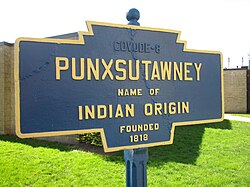Punxsutawney and Maxatawny
Language Log 2025-01-31
It's unlikely that I ever would have written a post on the strange-sounding name "Punxsutawney" because it is so well-known worldwide for groundhog Phil who lives there and can predict whether winter weather will persist after he wakes up from his hibernation, although it is nestled in the wooded hills about 85 miles northeast of Pittsburgh.
On the other hand, few have ever heard of Maxatawny, despite the fact that it is only 65 miles northwest of Philadelphia and situated on mostly flat land.
I never would have been aware of Maxatawny either, but for the miracle of the internet, because I happened upon it while surfing the www, which I have spent a goodly part of my life doing since its invention. When I saw mention of Maxatawny pop up on my computer screen, I was instantaneously nearly catapulted out of my seat because of its obvious likeness to Punxsutawney.
Years ago, I had tried to figure out the etymology of Punxsutawney and did — more or less — come to the realization that the nucleus of the name was -tawney and that it probably meant "town" (more about the derivation of "Punxsutawney" below). in any event, morphologically Punxsutawney and Maxatawny bear such a striking resemblance to each other that they must be related, even though Punxsutawney is about 250 miles west of Maxatawny.
Let's look at the two toponyms more closely:
Maxatawny is a name derived from a Native American language purported to mean "bear's path creek".
Hmmm…. I'm dubious about the accuracy of the translation.
We have a lot more information about the name of Phil's home ground:
Shawnee wigwam villages once occupied this site on the Mahoning Creek. The first settlement that included non-indigenous people was established in 1772, when Reverend John Ettwein, a Moravian Church missionary, arrived with a band of 241 christianized Lenape. Swarms of gnats plagued early settlers and their livestock for years, and are blamed for Ettwein's failure to establish a permanent settlement there. The clouds of biting gnats eventually drove the indigenous people away.
The indigenous people called the insects ponkies (living dust and ashes), and called their village Ponkis Utenink (land of the ponkies), from which the present name Punxsutawney evolved. One legend about the origin of the term ponkies concerned an old indigenous sorcerer-hermit who was said to have long terrorized indigenous people in the region. Eventually he was killed, his body burned, and his ashes were cast to the wind. According to the story, the ashes were transformed into minute living things that infested the swamp land. Another story about the source of the term asserted that the indigenous people compared the insect bites to burns caused by sparks or hot ashes.
The area was originally settled by the Lenape Indian tribe, and a more definitive source says the name Punxsutawney derives from a Native name in the Lenape language, Unami: Punkwsutènay, which translates to "town of the sandflies" or "town of the mosquitoes" (punkwës– 'mosquito' + –utènay 'town').
…
Settlers drawn by lumbering and coal mining eventually drained the swamps and exterminated the insects.
Phil, whatever the name of your hometown may mean — please, please, please don't see your shadow Sunday morning. Blink your eyes a few times, then hurry-scurry back down in your burrow and catch six more weeks of woozy winks. I am so, so tired of the bitter cold of the last two months.
Selected reading
- "The pragmatics of nyms, hyper- and hypo-" (8/28/21) — pertinent to this post in that MYL wrote it the day after having spent a couple of hours "swatting at mosquitoes and gnats" in a Pennsylvania state park
- "Year of the muroid" (2/9/20) — applies also to our snake posts and to groundhogs (and other kinds of "hogs"); don't miss the comments
BTW, how much wood would a woodchuck chuck if a woodchuck could chuck wood?
